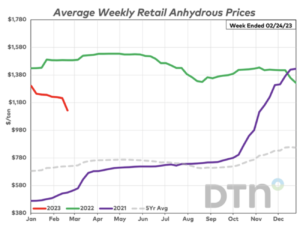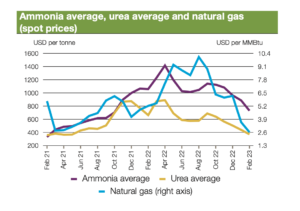Bloomberg's Leah Nylen reported Thursday that "a Colorado judge issued an order temporarily blocking the proposed $25 billion merger of Kroger Co. and Albertsons Cos., which has been challenged by…
Fertilizer Prices Continue to Fall
DTN writer Russ Quinn reported last week that, “Retail fertilizer prices continue their march lower, according to prices tracked by DTN for the third full week of February 2023. This trend has been with us since before the beginning of the New Year.
“All eight of the major fertilizer prices are once again lower compared to last month.”
“Leading the way lower was UAN32 and UAN28 once again. UAN32 was 12% lower compared to last month while UAN28 was 10% less expensive. UAN32 had an average price of $554/ton while UAN28 was at $470/ton,” the DTN article said.

Quinn added that, “Anhydrous was 9% lower looking back a month prior. The nitrogen fertilizer’s average price was $1,124/ton.”
The DTN article pointed out that, “All fertilizers are now lower compared to one year ago. DAP is 4% less expensive, MAP and 10-34-0 are both 11% lower, potash is 17% less expensive, UAN32 is 21% lower, UAN28 is 22% less expensive, anhydrous is 24% lower and urea is 25% less expensive compared to a year prior.”
Meanwhile, in its March Market Monitor report, the Agricultural Market Information System (AMIS) indicated that,
Fertilizer prices continued to fall in February due to weakening demand and further reductions in natural gas prices in Europe that incentivized production in the region.
“Similar to January, the price decreases were most significant for nitrogenous fertilizers that rely heavily on natural gas as an input. Global fertilizer supply continues to show a rebound from the turmoil seen in markets last year, but risks remain.”

The Monitor added that, “Natural gas prices decreased substantially in February, falling to their lowest levels since the war in Ukraine began. Unusually strong inventories have put a downward pressure on prices.

“Ammonia prices were down considerably in February with abundant supplies in global markets and a continued decrease in natural gas prices, which reduced ammonia production costs.

“Urea prices decreased in February in line with other nitrogenous fertilizer prices.”
Nonetheless, a farmdoc webinar last week (“Crop Risk Management for 2023, Part Two“) included the following slide, which shows a recent climb in the projected cost of producing corn in Central Illinois.






